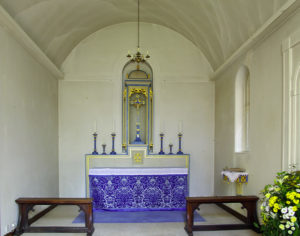It is easy to miss this small church tucked away off Trumpington Street and surrounded by trees. It has no tower or spire and almost impossible to photograph from the outside.
The church is thought to have Anglo-Saxon origins and was originally known as St Peter without Trumpington Gate. At the start of the C13th it was given to the Hospital of St John the Evangelist. By the late C13th, the church and its endowments were used to house scholars as well as the sick and infirm. This arrangement wasn’t successful and the students and the students moved into two houses to the south of the church. This was the origin of Peterhouse College, the first of the Cambridge colleges to be founded.
By the mid C14th the church was in a poor state and was rebuilt by the fellows of Peterhouse. It was rededicated to the Blessed Virgin Mary, being named Little St Mary’s to distinguish it from “Great St Mary’s”:http://wasleys.org.uk/eleanor/churches/england/cambridgeshire/cambridge_littlemary/index.html inside the city. The new building had a dual role of College chapel as well as parish church, until Peterhouse built their own chapel in the C17th.
The building suffered during the Commonwealth when the Puritan Iconoclast William Dowsing destroyed all the Medieval stained glass and statues. The church was repaired after the Restoration of the Monarchy and again later in the C18th with box pews, choir gallery and central pulpit. The south entrance was blocked and the north porch added from the base of the original tower. Apart from the pulpit which was moved to the side of the church, none of these survived the C19th restoration by Sir George Gilbert Scott. The Lady Chapel was added in 1931, on the site of a C16th chantry chapel and has a very different feel to the rest of the church.
Inside it is a simple rectangular building with whitewashed walls and large windows making the church very light. The wooden tie beams across the chancel ceiling are painted and have winged angels at the centre. High on the south wall is the organ, installed in 2007. Off the chancel is the crypt chapel which is used for midweek mass.
The east window was designed by CE Kempe and depicts the Annunciation. The high Altar was designed by Sir Ninian Comper in 1913 and is described as an ‘English altar’ with painted riddell posts and curtains. At the top of the posts are gilded angels. These would originally have faced inwards but have been turned to face the congregation. The candles are copies of the C17th candlesticks now in Peterhouse Chapel.
In niches on the east wall are painted statues of the Virgin Mary on the left and St Peter holding the keys of Heaven on the right.
At the back of the church on the west wall is the C19th wooden reredos designed by Gilbert Scott with Christ with St Peter and St John and flanked by the Virgin and the Angel Gabriel. This was replaced in 1913 by the Comper altar. In front of it is the C15th font.
On the north wall is an ogee arch which would have contained a tomb, but now has an Easter Garden.
The royal Coat of Arms of George II is above the archway in the south wall leading to the Lady Chapel. In the passageway is the crucifix memorial to the dead of the First World War.
The Lady Chapel is very simple with white walls, domed ceiling and bright blue altar frontal and candlesticks. Set in a Baroque recess is a blue and gold crucifix.
This attractive small church is off the usual tourist beat in Cambridge and receives few visitors. There is no parking close by. Although the address is Trumpington Street, access is off the narrow Little St Mary’s Lane. The church is open daily. The post code is CB2 1QG and the grid reference is TL 449580.
There are more pictures “here.”:http://wasleys.org.uk/eleanor/churches/england/cambridgeshire/cambridge_littlemary/index.html








